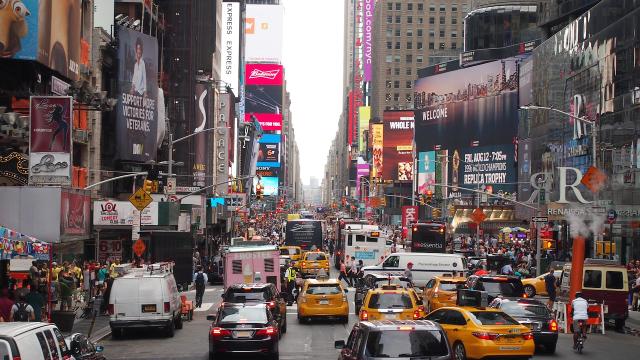A computer model developed by researchers at MIT shows that just 3000 Uber and Lyft vehicles, when carpooled, could replace New York City’s entire 14,000-strong taxi fleet. It’s a finding that highlights the potential for ridesharing apps to revolutionise transportation in big cities.
Image: ahundt/public domain
A new study published in the Proceedings of the National Academy of Sciences shows that 3000 four-passenger cars could serve 94 per cent of demand in New York City, while 2000 10-person vehicles could fulfil 95 per cent of demand — and with an average wait time of just 2.7 minutes and a trip delay of about 3.5 minutes. To make this efficiency a reality, however, most passengers would have to use the carpool feature on their Uber or Lyft apps, requiring them to share their ride with others and make multiple stops along the way.
The study, led by Professor Daniela Rus of MIT’s Computer Science and Artificial Intelligence Laboratory (CSAIL), demonstrates the power of carpooling when used in conjunction with ridesharing. New York City has about 14,000 taxi medallion licenses, but the new research suggests the city’s transportation infrastructure could function just as efficiently with a fleet one-quarter of this size.
Ridesharing, love it or hate it, is transforming the way we get around — and not just because it’s cheap. These services, as the new study attests, can significantly reduce the negative impact of traffic. Over the course of a single year, congestion costs Americans roughly $US121 billion ($168 billion) in lost revenue, 5.5 billion hours of time spent sitting in traffic jams and an additional 10.9 billion litres of fuel burned. Traffic also contributes to higher accident rates, pollution and greenhouse gas emissions.
On the downside, ridesharing platforms like Uber threaten the traditional taxi model, and the fuzzy legal status of their drivers has led to worker exploitation. Given its unregulated and often chaotic nature, ridesharing presents a host of other problems as well.
But Rus believes ridesharing in conjunction with carpooling can be a force for good. “Our ride pooling solution will reduce the number of vehicles needed to support the transportation demands of a city but this does not mean that the driving jobs are going away,” she told Gizmodo. “Another way to think about this is that the jobs are getting better: Drivers will be able to make the same amount of money working shorter shifts — while the customers will get the same level of service, cities will have fewer cars on roads, the commute experience will be better for everyone in the city, and the air is cleaner.”
By analysing data from three million NYC taxi rides (excluding trips going in or out of Manhattan), the CSAIL algorithm rerouted simulated cars as requests for rides trickled in, and it did so in real-time. To increase efficiency, the system sent idle cars to areas of high demand, making the service 20 per cent faster. Unlike previous studies, which were limited to static routes with two or three riders per vehicle, the new model was able to adjust to changing conditions on the fly, altering the routes when new passengers appeared, and selecting vehicles of different sizes when needed.
This is the first study to experimentally quantify the tradeoffs between fleet size, capacity, waiting time, travel delay and operational costs for a wide range of vehicles. The research also speaks to the prospect of self-driving rideshare vehicles.
“The feature of being able to reroute idle cars makes this particularly well suited for autonomous vehicles, since they can be even more easily rerouted than human drivers that may decide to end their shift or do a personal errand elsewhere,” Rus said. “Also using the system assumes that the human drivers go where the system tells them to go. Some human drivers may not follow the system suggestions, but we would expect a self-driving vehicle to respond in a timely manner.”
The researchers say their system can be used by existing fleets, entire cities or new businesses. It’s not necessary for everyone to participate, and people can continue to have private driving experiences. Even if some fraction of the rides are shared, there will be fewer vehicles on the roads.
The system works by creating a graph of all of the requests and all of the vehicles. A second graph is then created showing all possible trip combinations. The computer then calculates the best assignment of vehicles for the trips. Idle cars are “rebalanced” and dispatched to areas of high demand. The system learns as it goes, getting better with each iteration.
This study was limited to Manhattan, so it isn’t clear how the system would fare in other major urban centres. The researchers did not consider the role of public transportation, but said they’d be happy to use that data in collaboration with cities to ensure that their results hold up when they have “a fuller picture of the transportation landscape”.
It’s unlikely that every single Uber or Lyft user is going to suddenly start choosing to carpool to reduce traffic and help the environment. But if algorithms like this are integrated into these apps, and if passengers buy into the system, carpooling could start to become a more attractive option.
“From an environmental perspective, using a ride-sharing service is certainly preferable to having your own a car,” said Rus. “But if we can make it more socially acceptable to share car rides, and if we can make sharing a high quality experience, that will make transportation much better.”
